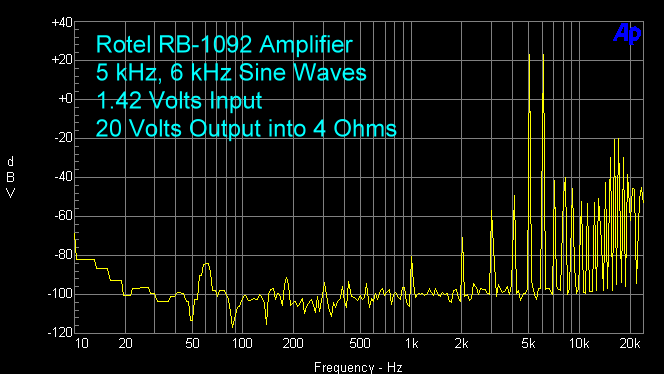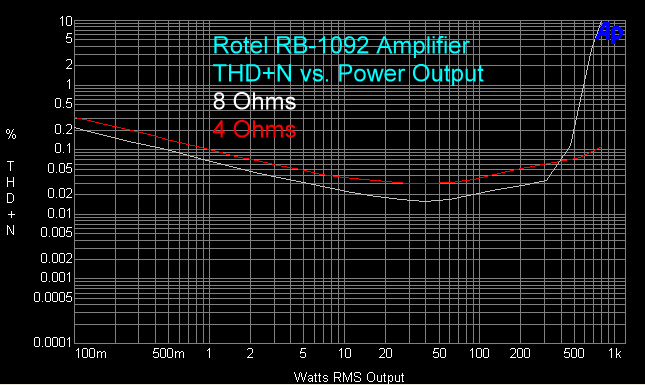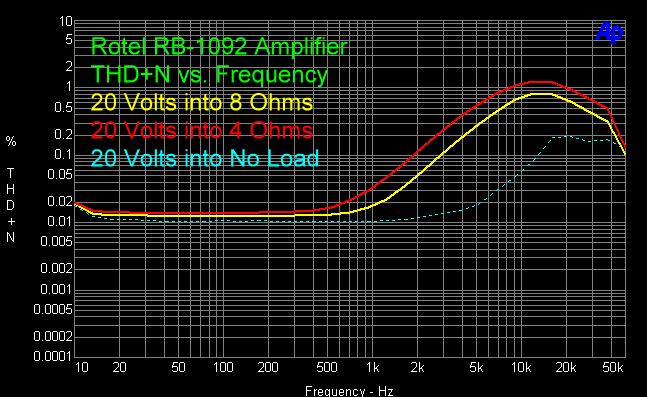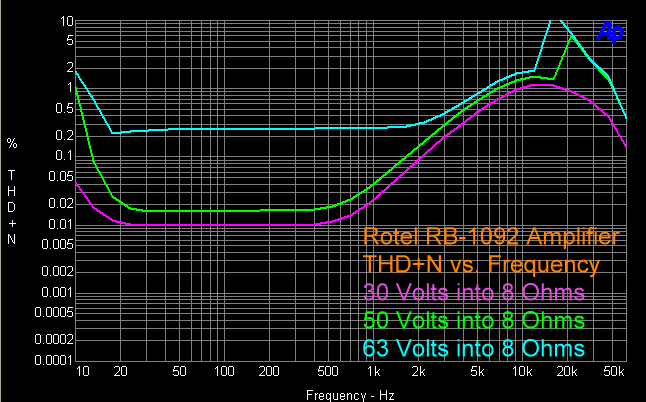|
||||||
|
With 5 kHz and 6 kHz sine wave test frequencies, and 20 volts into 8 ohms, the A+B peak at 11 kHz was 84 dB below the test frequencies, and the B-A peak at 1 kHz was - 106 dB. This test is non-standard, so there are no SMPTE/DIN resulting IMD numbers.
At 4 ohms, the A+B peak was at - 77 dB, and the B-A peak was at - 104 dB.
For 10 kHz and 11 kHz test signals - again, a non-standard test, so we don't have SMPTE/DIN data - A+B at 21 kHz was - 70 dB, and B-A at 1 kHz was - 108 dB.
At 4 Ohms, A+B was at - 72 dB, and B-A was at - 112 dB.
The measured frequency response was 10 Hz to 20 kHz ± 0.3 dB. This "restricted" frequency response is common with switching amplifiers so as not to have the output frequencies being affected by the switching frequency.
For THD+N vs. Power Output, the Rotel RB-1092 delivered 600 watts RMS into 8 ohm loads with both channels operating, before clipping (defined as 1% THD+N). At 4 ohms, the amplifier shut down at 800 watts RMS output, with both channels operating. That is a lot of power!
THD+N vs. Frequency, at 5 volts RMS output into various loads showed a rise above 2 kHz for 8 and 4 ohms.
At 20 volts output, and a 4 ohm load, THD+N rose above 1% between 10 kHz and 20 kHz. However, the harmonics would not be audible for the most part (the second harmonic of 10 kHz is 20 kHz, just barely audible even when you are young). Keep in mind that all amplifiers have a rise in THD+N in the upper frequencies, even the $21,000 Lamm monoblocks, and Mark Levinson power amplifiers, which are among the finest in the world. What you pay for is the amount of rise that occurs. The flatter the curve, the more neutral the sound. The higher the rise, the brighter the sound. If the rise starts at a lower frequency, the result might be heard as a midrange "bloom". The tradeoff with the RB-1092 is that you have an enormous amount of power that will deliver better dynamics than a lower power Class A/B amplifier, but with more brightness (less neutral). Of course, this depends on the design. There are some Class A/B amplifiers out there that are somewhat bright as well. And, this is not necessarily unappealing. It is all based on the listener's preferences. Many consumers like the brightness, which adds an edge to the sound. Midrange bloom adds body.
At very high output, here is where the current crop of switching amplifiers don't perform as well as Class A/B. Notice that at 50 volts and 63 volts output (312 watts and 496 watts respectively, into 8 ohms), THD+N rises above 1% at 10 Hz and above 5 kHz. The 10 Hz distortion would not be audible, but the 5 kHz and above might be, although the speakers would be distorting far more than 1% at such a high volume, so this is not necessarily a significant issue. In fact, Jared said that the sound was great at high volume, although I suspect he never came near 300 watts being delivered to the speakers. So, my feelings on this are that, at conventional volume levels, the amplifier should be fine. For the transient peaks, which might require 300 watts or more, everything would be distorting: amplifier, speakers, and probably your ear drums, and it would be for a very short duration.
Conclusions Some people enjoy having mammoth sized amplifiers costing megabucks. Others don't have the space, the money, or the spouse approval to do so. Clearly, manufactures are aware of this and are adding components to their lineup that are able to meet these requirements. You have always been able to buy small efficient switching power amplifiers. Unfortunately, they were often very expensive, terrible sounding, or worse . . . both. We are seeing more choices now of smartly designed, quality components that deliver the goods without taking up too much space. It doesn't come absolutely cheap however, for $2500 only gets you two channels. Of course that is two channels of virtually bottomless power mind you. In fact, the power delivered by this amp was astounding and the B&W 804 towers are able to throw forward some serious sound when pushed hard. I never found myself wishing for more power or being fatigued with extended listening even with my heavier discs. I love hearing new layers within my old music, and the Rotel amp did just
that. Rotel has constructed a high
quality dual-mono class D that excels from the bottom up. - Jared Rachwalski -
|
||||||












